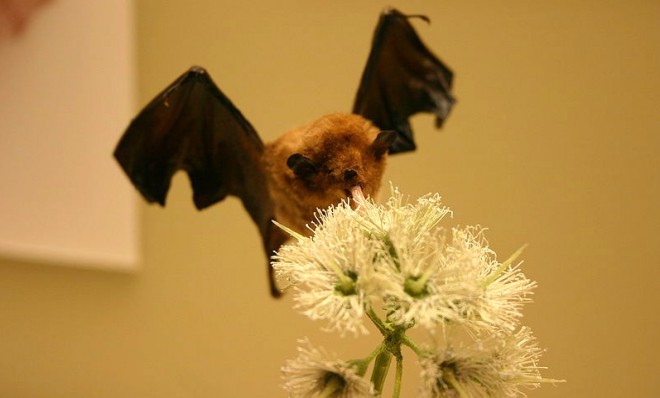Tongue erections: The adaptation that helps bats lap up nectar
Bat tongues contain all the complex plumbing needed for an erection: Veins, arteries, and a hemodynamic pump that allows the tongue to swell with blood

Hovering over a flower to feast on nectar isn't easy. All that wing-flapping can really drain the energy out of an airborne creature, making it in a winged animal's best interest to suck up all those tasty nutrients as quickly as possible.
To that end, hummingbirds have evolved long, straw-like beaks and forked, bifurcated tongues with more surface area. Bees have long, hairy tongues that literally soak up all that liquid vitality, kind of like a mop.
Nectar-guzzling bats — in this case, Glossophaga soricina — have similar hair-like projections coating their tongues. They're called papillae, and are essentially "specialized versions of the bumps that dot the tongues of humans and other mammals," as LiveScience's Stephanie Pappas describes it. But bats boast a more eye-catching adaptation, too: When a bat is about to feed, its tongue engorges with blood, growing in size and causing its papillae to stand tall.
The Week
Escape your echo chamber. Get the facts behind the news, plus analysis from multiple perspectives.

Sign up for The Week's Free Newsletters
From our morning news briefing to a weekly Good News Newsletter, get the best of The Week delivered directly to your inbox.
From our morning news briefing to a weekly Good News Newsletter, get the best of The Week delivered directly to your inbox.
The bats get what is essentially a tongue erection.
This evolutionary phenomenon was recently observed in a new experiment conducted by biologists at Brown University, and published in the Proceedings of the National Academy of Sciences, or PNAS. Researchers used high-speed cameras to capture in pristine detail exactly how the bats' tongues extended on command.
"We've known of these elongated hairs, or papillae, at the tongue tip for a long time," study co-author Cally J. Harper tells National Geographic. "But it was really only when we looked at them with color, high-speed videos that we could see they actually changed their orientation and rose up perpendicular to the tongue during feeding, and that it was due to the flow of blood into the tongue."
As this video demonstrates, the tongue's papillae stand tall even if the creature fails to reach any nectar. Upon dissection, researchers found that bat tongues contained all the complex plumbing needed for an erection: Veins, arteries, and a hemodynamic pump that allow the tongue to swell up with blood.
A free daily email with the biggest news stories of the day – and the best features from TheWeek.com
As Kate Shaw at Ars Technica notes, this all happens very, very quickly. One lap takes all of 100 milliseconds. "To put that speed in perspective, it takes us nearly four times that long to simply blink once," Shaw says.
-
 Political cartoons for January 4
Political cartoons for January 4Cartoons Sunday's political cartoons include a resolution to learn a new language, and new names in Hades and on battleships
-
 The ultimate films of 2025 by genre
The ultimate films of 2025 by genreThe Week Recommends From comedies to thrillers, documentaries to animations, 2025 featured some unforgettable film moments
-
 Political cartoons for January 3
Political cartoons for January 3Cartoons Saturday's political cartoons include citizen journalists, self-reflective AI, and Donald Trump's transparency